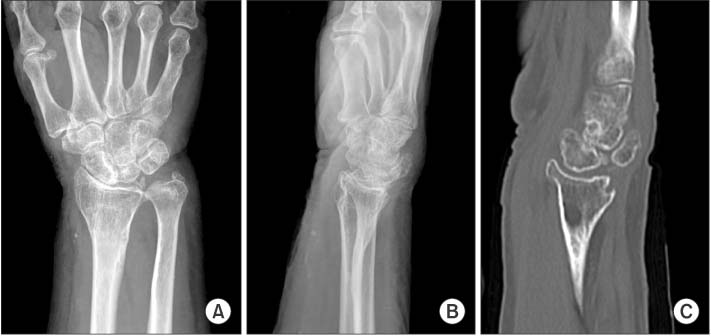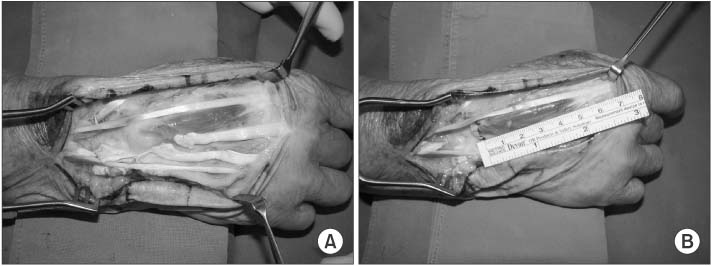J Korean Orthop Assoc.
2015 Dec;50(6):527-531. 10.4055/jkoa.2015.50.6.527.
Extensor Indicis Brevis: A Case Report
- Affiliations
-
- 1Department of Orthopedic Surgery, Konyang University Hospital, Konyang University College of Medicine, Daejeon, Korea. hurym1973@hanmail.net
- KMID: 2185094
- DOI: http://doi.org/10.4055/jkoa.2015.50.6.527
Abstract
- Anatomical variations of the extensor tendon of the hand are common. However, the majority of anomalous variations are asymptomatic throughout a lifetime and are found incidentally during surgery or after trauma of the hand. The index finger has two independent extensor tendons and lower incidence of anomalous variations than other extensor tendons. We experienced a rare muscular variant of extensor indicis proprius (EIP) during a tendon reconstruction for spontaneous rupture of the 3rd and 4th extensor digitorum communis. Tendon reconstruction using EIP was planned preoperatively. However, EIP was absent and anomalous muscle known as extensor indicis brevis, which originated from the capsular ligament of the wrist and inserted into the ulnar side on the 2nd extensor digitorum communis of the extensor hood, was found. We performed tendon reconstruction using an alternative surgical procedure because extensor indicis brevis was not useful. Attention is required during tendon reconstruction because anatomical variation of EIP may affect a surgical procedure.
Figure
Reference
-
1. Tan ST, Smith PJ. Anomalous extensor muscles of the hand: a review. J Hand Surg Am. 1999; 24:449–455.
Article2. Komiyama M, Nwe TM, Toyota N, Shimada Y. Variations of the extensor indicis muscle and tendon. J Hand Surg Br. 1999; 24:575–578.
Article3. Cauldwell EW, Anson BJ, Wright RR. The extensor indicis proprius muscle: a study of 263 consecutive specimens. Q Bull Northwest Univ Med Sch. 1943; 17:267–269.4. Bingold AC. An extensor indicis brevis. Br J Surg. 1964; 51:236–237.
Article5. Murakami Y, Todani K. The extensor indicis brevis muscle with an unusual ganglion. Clin Orthop Relat Res. 1982; 162:207–209.
Article6. Dunn AW, Evarts CM. The extensor digitorum brevis manus muscle: a case report. Clin Orthop Relat Res. 1963; 28:210–212.7. Gahhos FN, Ariyan S. Extensor indicis brevis: a rare anatomical variation. Ann Plast Surg. 1983; 10:326–328.
Article8. Spinner M, Olshansky K. The extensor indicis proprius syndrome. A clinical test. Plast Reconstr Surg. 1973; 51:134–138.9. Gama C. Extensor digitorum brevis manus: a report on 38 cases and a review of the literature. J Hand Surg Am. 1983; 8:578–582.
Article10. Ogura T, Inoue H, Tanabe G. Anatomic and clinical studies of the extensor digitorum brevis manus. J Hand Surg Am. 1987; 12:100–107.
Article
- Full Text Links
- Actions
-
Cited
- CITED
-
- Close
- Share
- Similar articles
-
- Congenital Absence of Extensor Indicis Proprius Tendon, Bilateral: A Case Report
- A Variant Extensor Pollicis Brevis Crossing the Anatomical Snuff Box
- A rare bilateral variation on the dorsum of the hand: extensor digitorum brevis manus and extensor medii proprius
- Variations of Insertions of the Abductor Pollicis Longus and the Extensor Pollicis Brevis in Korean
- Muscular Variations of Extensor Digitorum Brevis Muscle Related with Anterior Tarsal Tunnel Syndrome




